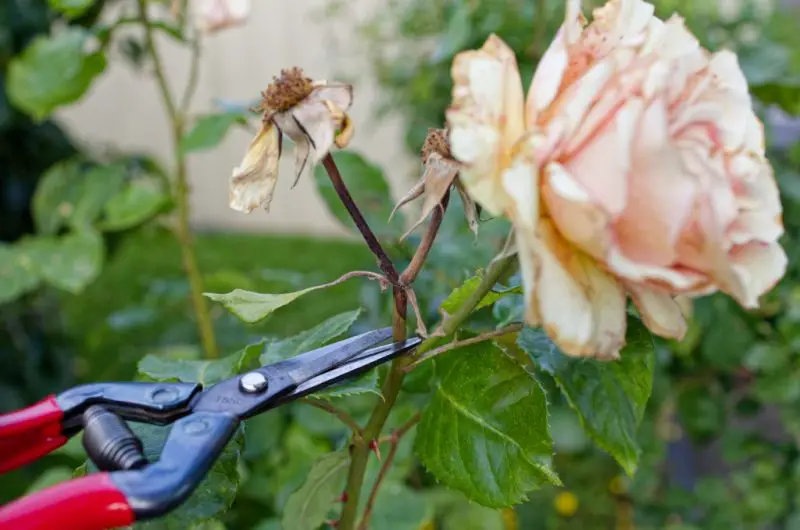Roses are one of the most beloved flowering plants, admired for their beauty, fragrance, and wide range of colors. To keep them blooming abundantly throughout the growing season, deadheading is an essential gardening practice. Deadheading simply means removing faded or spent flowers, encouraging the plant to produce more blooms instead of directing energy toward seed production. This not only keeps your rose bushes looking neat but also stimulates continuous flowering. In this comprehensive guide, you’ll learn exactly how to deadhead roses for more blooms, following proven techniques used by seasoned gardeners.
Deadheading roses may seem like a simple task, but knowing the right time, technique, and tools can make a significant difference in your rose plant’s overall performance. Whether you’re tending to hybrid teas, floribundas, or climbing roses, understanding their growth habits and bloom cycles is the first step toward successful deadheading. With consistent care and proper pruning, your roses will reward you with vibrant, lush blossoms all season long.
In this guide, we’ll walk you through every detail of deadheading—from identifying spent blooms to executing clean cuts and understanding the plant’s growth response. By the end of this article, you’ll have the knowledge and confidence to enhance your rose garden’s appearance and productivity through effective deadheading practices.
Why Deadheading Roses Promotes More Blooms

When a rose flower fades and is left on the plant, it signals the beginning of seed development. The plant naturally shifts its energy toward forming rose hips, which are the fruit that contain seeds. This process diverts resources away from new flower production. By removing these spent blooms in a timely manner, you redirect the plant’s energy into developing new buds and extending the blooming season.
Another important reason for deadheading is to maintain the aesthetic appeal of your rose garden. Faded flowers can make even the most beautiful bushes look tired and neglected. Deadheading helps the rose bush look cleaner, more vibrant, and professionally maintained, giving your garden a refined and flourishing appearance.
Additionally, deadheading can reduce the likelihood of disease and pest issues. Spent blooms can harbor fungal spores and attract insects, so removing them keeps your plants healthier. This is especially beneficial in humid climates or during rainy periods when moisture increases the risk of black spot and powdery mildew.
Understanding the Rose’s Growth Cycle
Before you begin deadheading, it’s helpful to understand the growth cycle of a rose. Roses typically bloom in cycles, with a burst of flowers followed by a period of rest and then renewed growth. During each blooming cycle, the plant produces flower buds on new shoots that emerge from mature canes. Once the flowers fade, the plant will either begin forming seed pods or produce more lateral growth to initiate new blooms.
The key to effective deadheading is to encourage the rose to repeat its bloom cycle as quickly and efficiently as possible. This can be achieved by pruning just above a healthy set of leaves, where new growth can sprout. Each rose variety has slightly different growth patterns, so becoming familiar with the type of rose you’re growing will help you predict how it will respond to deadheading.
Hybrid tea roses, for example, tend to produce single flowers on long stems and respond well to aggressive deadheading. Floribunda roses bloom in clusters and benefit from lighter pruning. Climbing roses may only bloom once or twice a year, so their deadheading needs may differ slightly from reblooming varieties.
The Best Time to Deadhead Roses
Timing is a crucial element when it comes to deadheading roses. The best time to remove spent blooms is shortly after the petals begin to wilt or fall off. At this stage, the flower has completed its bloom cycle but has not yet begun developing seeds. This window provides the optimal opportunity to redirect the plant’s energy into producing new blooms.
Deadheading can be done continuously throughout the blooming season, from early summer until late fall, depending on your climate zone. It’s important to monitor your rose bushes regularly and remove faded flowers as soon as they are past their prime. This encourages the plant to remain in active growth mode, producing multiple bloom cycles throughout the season.
In some regions, roses continue blooming even into early winter if the temperatures remain mild. However, it’s advisable to stop deadheading about six weeks before the first expected frost. This allows the plant to enter dormancy gradually and prepare for the colder months, which is especially important for preventing winter damage.
Choosing the Right Tools for the Job
Deadheading roses requires only a few basic tools, but selecting the right ones ensures clean cuts and healthy regrowth. A sharp pair of bypass pruners is ideal for removing spent blooms. These pruners provide a precise cut that does not crush the stem, reducing the risk of damage or disease entry.
It’s essential to keep your pruning tools clean and sharp. Wipe the blades with rubbing alcohol or a disinfectant solution between uses, especially if you’re working on multiple plants. This practice prevents the spread of fungal spores and bacteria, which can infect open cuts on the rose stems.
In addition to pruners, you may want to use gardening gloves, particularly when handling thorny rose varieties. Gloves protect your hands from scratches and make it easier to handle stems while maintaining a firm grip during pruning.
How to Identify Spent Rose Blooms
Recognizing when a rose flower is spent is key to effective deadheading. A spent bloom typically shows drooping petals, fading color, or petal drop. The center of the flower may become exposed, and the overall structure of the bloom will appear loose or disorganized.
You should also look for signs of seed development, such as swelling at the base of the flower where rose hips form. If you allow this process to continue, the plant will slow down its flowering efforts and concentrate on seed formation instead. Removing the bloom before this stage interrupts the seed cycle and promotes more flower production.
Another helpful indicator is the appearance of the surrounding foliage. If the leaves beneath the bloom begin to turn yellow or look stressed, it may suggest that the flower has reached the end of its cycle. At this point, deadheading is not only appropriate but necessary to revitalize the plant.
Where to Make the Cut When Deadheading
The location of your cut plays a critical role in encouraging new growth. The general rule is to cut just above the first five-leaflet leaf stem that faces outward from the plant. This ensures that the new shoot will grow away from the center, promoting good air circulation and an open shape.
When making the cut, aim for a 45-degree angle, sloping away from the bud. This allows water to run off the cut surface, minimizing the risk of rot or fungal infection. Avoid leaving stubs, as they can become entry points for pests and disease.
If you’re deadheading a single bloom, trace the stem down to the five-leaflet node and make your cut cleanly above it. In the case of floribunda roses or cluster blooms, remove the entire flower cluster once most of the flowers have faded, making the cut just above a healthy leaf set on the main stem.
Deadheading Different Types of Roses
Each type of rose requires slightly different care when it comes to deadheading. Hybrid tea roses, which produce large, singular blooms on long stems, respond well to more aggressive deadheading. Removing the bloom and a portion of the stem down to a strong leaf set encourages the production of a new flowering cane.
Floribunda roses, known for their clustered blooms, require a more delicate approach. Instead of removing each individual flower, wait until the entire cluster has finished blooming. Then, prune just below the cluster to stimulate the growth of new flower heads.
Shrub roses and landscape roses, such as Knock Out® or Drift® varieties, are typically self-cleaning, meaning the spent flowers fall off on their own. However, manually removing faded blooms can still enhance the plant’s appearance and encourage more prolific flowering.
Climbing roses and old garden roses often have a single flush of blooms each year, so deadheading may not be necessary to encourage reblooming. Still, removing spent flowers can help maintain a tidy appearance and prevent seed formation, which conserves the plant’s energy.
Caring for Roses After Deadheading
After you’ve completed deadheading, it’s important to care for your roses to support healthy regrowth. Water your plants deeply at the base to keep the roots hydrated, especially during hot or dry weather. Avoid overhead watering, which can promote disease on the leaves.
Applying a balanced, slow-release fertilizer after deadheading provides essential nutrients that support new bud development. Look for a rose-specific fertilizer or a formula with equal parts nitrogen, phosphorus, and potassium to encourage both growth and flowering.
You can also apply a layer of mulch around the base of the plant to retain soil moisture and regulate temperature. Mulch helps prevent weed growth and reduces water evaporation, which is especially useful during the peak blooming season.
Regularly check for signs of pests such as aphids or spider mites, as new growth can be attractive to these insects. If detected early, they can be managed with insecticidal soap or horticultural oil to minimize damage.
Common Deadheading Mistakes to Avoid
While deadheading is straightforward, there are a few common mistakes that can hinder your rose’s blooming potential. One mistake is cutting too high above the leaf node, which can result in a stub that may become diseased. Always cut close to the node without damaging it.
Another issue is deadheading too aggressively or too often, which can stress the plant, particularly in hot climates. Give your rose time to recover between pruning sessions, and avoid removing foliage unnecessarily.
Failing to clean your tools is another overlooked issue. Dirty blades can transfer disease between plants, so make it a habit to disinfect your pruners regularly.
Finally, avoid deadheading too late in the season. Roses need time to harden off before winter arrives. Continuing to deadhead late into fall can delay this process and increase the risk of frost damage.
The Long-Term Benefits of Deadheading
Consistent deadheading contributes to the long-term health and vitality of your rose bushes. Over time, it encourages bushier growth, more abundant flowering, and a more refined garden appearance. Deadheaded roses also tend to develop stronger root systems and are better equipped to resist pests and diseases.
In addition to physical benefits, the act of deadheading creates an opportunity to monitor your plants regularly. This helps you catch any issues early and respond proactively, whether it’s spotting black spot on the leaves or noticing poor soil drainage.
For gardeners who take pride in a flourishing rose display, deadheading is not just a chore but a rewarding part of plant care. Watching your roses respond with vigorous new growth and another round of fragrant blooms is a testament to the effectiveness of this simple technique.
Frequently Asked Questions about How to Deadhead Roses
What happens if you don’t deadhead roses?
If you don’t deadhead your roses, they will begin producing seed pods called rose hips. This signals the plant to stop blooming and enter a different phase of growth. The bush may also appear untidy and may bloom less profusely in the long run.
How often should you deadhead roses?
You should deadhead roses regularly throughout the growing season, ideally every few days or whenever you see faded blooms. Timely removal of spent flowers helps maintain continuous blooming and a well-kept appearance.
Can you deadhead roses with your fingers?
While it is possible to deadhead roses with your fingers in soft-petaled varieties, using pruners is more effective and ensures a clean cut. Avoid tearing or pulling the stem, which can damage the plant and invite disease.
Conclusion
Learning how to deadhead roses for more blooms is one of the most rewarding skills a gardener can develop. This simple but powerful practice encourages more flowers, keeps your rose bushes looking neat, and contributes to their overall health. By following the step-by-step approach outlined in this guide, you can maximize your rose garden’s beauty throughout the season. With a little time and care, your roses will thrive and dazzle with continuous, vibrant blooms.






